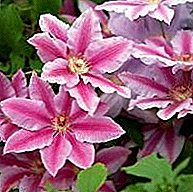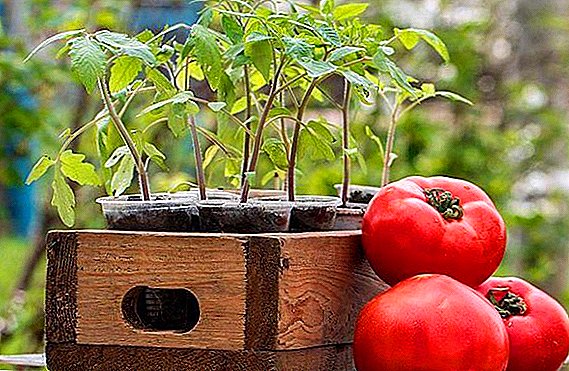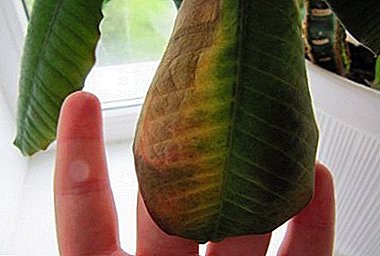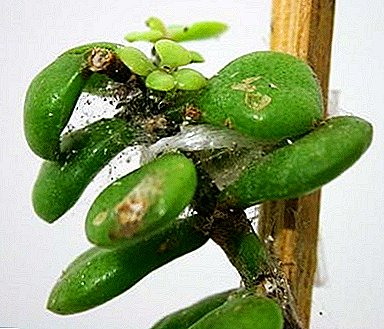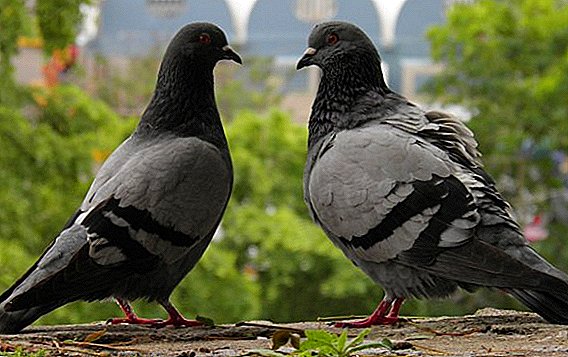
Growing orchids at home is a time-consuming, troublesome, and requiring knowledge and experience. This exotic beauty requires a certain care and attention, only then it will delight the stormy colorful flowering and growth.
Feeding, lighting, the right temperature, are of great importance, but the main thing in caring for the plant is its proper watering. Consider in our article the methods and rules for irrigating exotic beauty orchids. You can also watch a useful video on this topic.
Features
Do not think that in the wild the orchid is a parasite, although it grows by attaching to the bark. The roots of the plant are woven in such a way as to catch dew, fog and precipitation.. In addition, plant waste falls on them, which is rotting to give the flower the necessary vitamins and trace elements.
 So she gets food in most cases from the sun and water. In addition, it should be borne in mind that the roots of the plant after heavy rains are immediately blown by the wind, and are in a dry state for a long time.
So she gets food in most cases from the sun and water. In addition, it should be borne in mind that the roots of the plant after heavy rains are immediately blown by the wind, and are in a dry state for a long time.
When watering at home you need to take into account a very important factor - sunlight, the more of it, the more abundant the watering. As soon as the activity of the sun and daylight decreases, the orchid falls into a dormant period and the watering becomes moderate. You should not also forget that epiphytes are able to accumulate moisture in the root system, and then gradually use it. And if at home a wet substrate is constantly in the pot with the plant, the roots will start to be affected by the rot (how to water the orchid in the pot or in the pots, read here).
In addition, there is another factor that should be considered when watering - the type of plant. For example, Phalaenopsis, Lady's Slipper, Miltonia and Cymbidium practically do not tolerate the lack of moisture and drying. Their roots must be constantly moistened, and they do not tolerate stagnant water.
But Dendrobium, Oncidium, Cattleya and Odontoglossum prefer to be watered only after the substrate dries out completely.
General tips
There are a few mistakes that novice flower growers make that should be considered:
- Overflow. Despite the fact that the homeland of orchids - the tropics, they can not tolerate waterlogging. For them, the soil moisture is not important, but rather it is necessary to pay attention to the humidity of the air.
- Hard water. Watering the plant with water from the tap, flower growers are ruining it. Orchid is accustomed to eat soil moisture, which is enriched with mineral salts. It is necessary to water only soft, thawed, rain or boiled water.
- Watering from above. It is impossible that the moisture stagnated in the leaf axils, they can rot, which will lead to the death of orchids. Therefore, watering should be carried out in a special way.
- Untimely wateringwhich does not take into account the period of active growth of the plant. As soon as the plant goes into hibernation, watering is reduced to a minimum.
We recommend watching the video about errors when watering orchids:
Watering frequency
 It is impossible to answer this question unequivocally, since everything depends on the growing season, air humidity and temperature. At certain periods of growth, an orchid requires more moisture or less. You can only say one thing - it is better to water the orchid rarely, but plentifully.
It is impossible to answer this question unequivocally, since everything depends on the growing season, air humidity and temperature. At certain periods of growth, an orchid requires more moisture or less. You can only say one thing - it is better to water the orchid rarely, but plentifully.
When growing an orchid without experience, you can rely on recommendations: in the summer, 1-3 times a week, during the rest period, 1-2 times a month. Gradually, you can develop your own watering schedule.watching her beauty.
About how often you need to water the orchid, said in our article.
How to understand that the plant needs moisture?
There are certain signs that allow you to determine whether to water the orchid or not.
- The pot has become easy. Often, beginners find this method very difficult, but if you gain some experience, it will be very easy by weight to recognize whether it is worth watering an orchid.
- There is no condensation on the inside walls of the pot.. This method is well suited if the orchid grows in a transparent pot.
- Lightening the roots. If orchids have green roots, then orchid moisture is enough - if they are white, then it's time to water.
Board: You can conduct a simple test for the humidity of the substrate. Take a wooden skewer and pierce the soil, if after you pull it out it is dry - you can safely water the plant.
We recommend to watch the video on how to determine whether it is time to water the orchid:
What water to use?
For orchids, the quality, composition and temperature of water is very important.. If in nature it feeds on rainwater in which there are practically no salts and acids, then the moisture entering the apartment through pipes contains almost the entire periodic table, which may affect the ability of the orchid to fully bloom. What water to use for irrigation? To avoid unpleasant surprises, for watering orchids you should use only purified, soft water, from which all impurities and heavy metals are removed.
You can boil water, then:
 chlorine compounds contained in tap water will evaporate;
chlorine compounds contained in tap water will evaporate;- salts will precipitate;
- pathogenic microflora is destroyed;
- the concentration of ferrous compounds decreases.
It should immediately be said that upholding cannot give a positive result, since it takes a lot of time to get rid of impurities. As for the microflora, then it will develop the opposite. Do not use distilled water for irrigation, as there are no nutrients in it at all.. Such a liquid can spray the plants, dilute mineral fertilizers in it. It will also be useful to warm the water to a temperature of 30 degrees.
About how to water the plant with water, read here.
Step-by-step instruction
Watering should be carried out strictly according to the instructions, otherwise the inexperience can destroy the plant. To begin, we will prepare all the necessary:
- lots of warm water;
- grid with holes;
- transparent dishes, a little larger in diameter than a pot with orchid;
- plant in the pot;
- watering can for watering flowers or mug;
- old thick towel.
Rules for watering orchids by immersion:
- Set the flower pot in the prepared, empty dishes.
- Carefully begin to water the plant from above, trying not to fall on the leaves. At the same time water flows into the tank in which the pot is installed.
- As soon as the liquid level closes the orchid pot by a third, leave the plant for 5 minutes.
- Then we begin to water again until the level of the liquid reaches two thirds, stop and wait another 6 minutes.
- Then add water in such a way that 1 cm to the edge of the pot remains. Leave the plant for 9 minutes.
- In total, the orchid pot will stand in the water for 20 minutes, this is enough for the substrate to soak in moisture.
- We take out the pot with orchid and set it on the grid, under which is a thick towel. We leave the plant for half an hour - this is enough to make the glass extra water.
- Watering orchids finished, you can move it to a permanent place.
Important: It is necessary to strictly monitor how much time a flower spends in water and how much is needed for the stack, since stagnant moisture in the substrate will lead to rotting of the roots and the death of the orchid.
We recommend to watch the video about watering orchids by immersion:
What watering is considered correct?
Proper watering is very important to the plant. In the case of orchid - it is better not to pour than pour. If at home the orchid is in constant conditions without temperature drops, then you can water it at any time. If it is cool at night, then watering is transferred in the morning. The frequency of watering depends on:
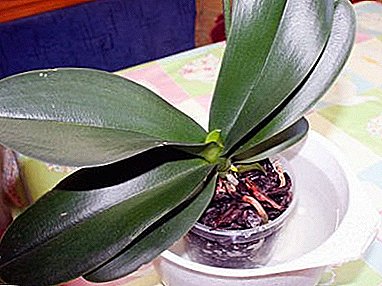 from the life cycle;
from the life cycle;- time of year;
- temperature conditions;
- humidity in the room;
- varieties of plants.
To water properly is to make it so that:
- water did not stagnate in the substrate;
- the plant was more time in dry soil than in wet;
- watering was carried out by setting the pot with orchid in the water.
Watering is not correct if the orchid is always in a wet substrate., and at the bottom of the pot moisture stagnates. It is also wrong to water the flower from above, when water stagnates at the growth point and in the leaf axils.
If condensation is visible on the walls of the pot, and the roots are wet, thick and bright green, then the plant should not be watered - there is enough moisture for it.
Irrigation Results
Disease and root rot result from improper watering.. If the plant is sick, then one way out - transplanting, with the removal of damaged areas.
Conclusion
Watering an orchid is not difficult, the main thing is to follow the instructions described above. It should also be borne in mind that for each plant a new portion of water is taken so that possible diseases do not spread to all plants. Over time, you will be able to develop your own irrigation system, which is ideal for the conditions of plant maintenance in your apartment.


 chlorine compounds contained in tap water will evaporate;
chlorine compounds contained in tap water will evaporate; from the life cycle;
from the life cycle;